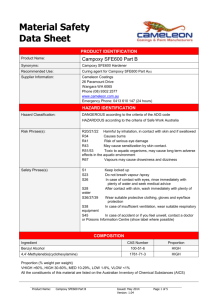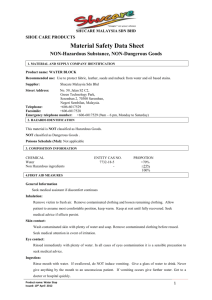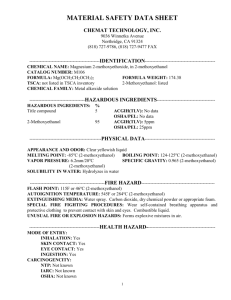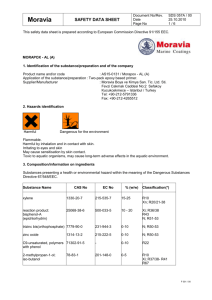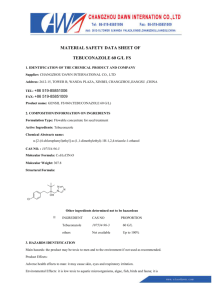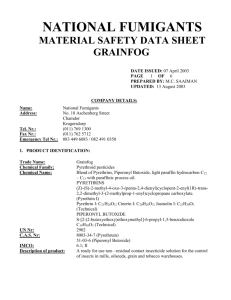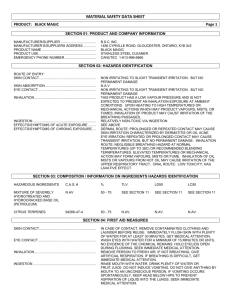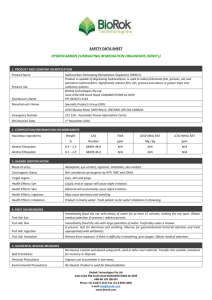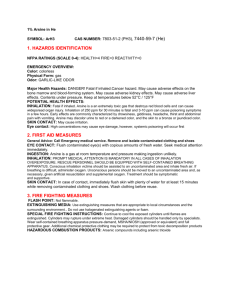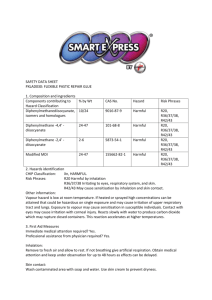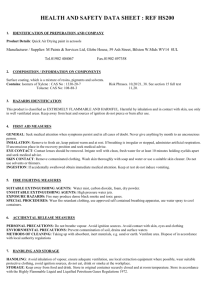Section 1 - Guardian Protective Coatings
advertisement
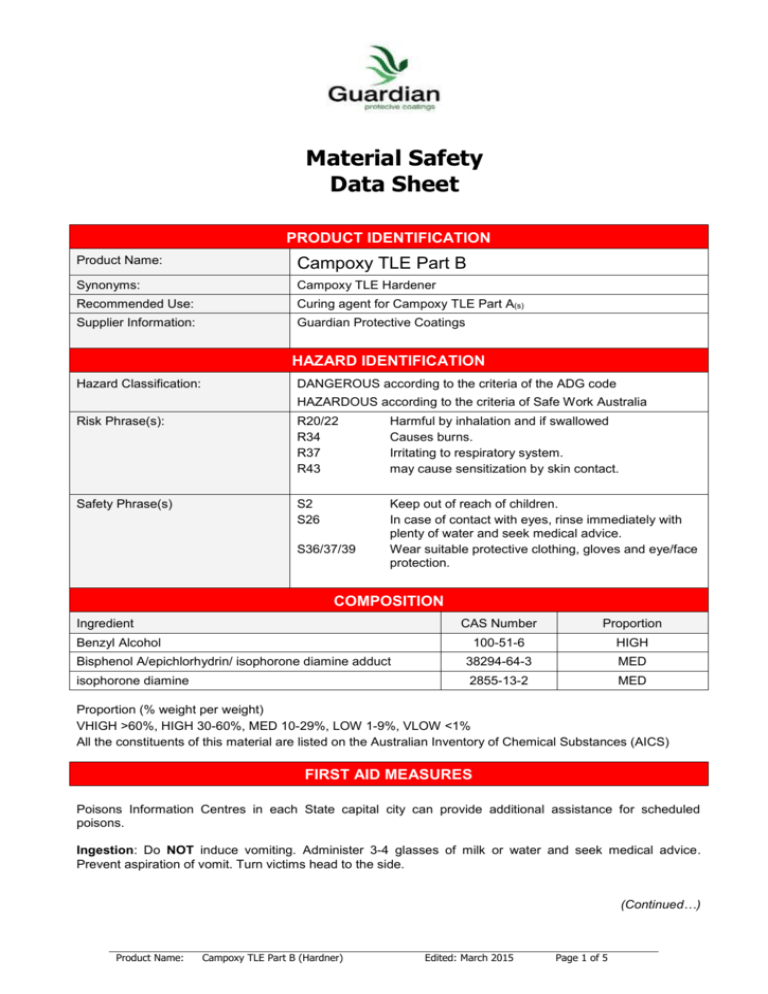
Material Safety Data Sheet PRODUCT IDENTIFICATION Product Name: Campoxy TLE Part B Synonyms: Campoxy TLE Hardener Recommended Use: Curing agent for Campoxy TLE Part A(s) Supplier Information: Guardian Protective Coatings HAZARD IDENTIFICATION Hazard Classification: DANGEROUS according to the criteria of the ADG code HAZARDOUS according to the criteria of Safe Work Australia Risk Phrase(s): R20/22 R34 R37 R43 Harmful by inhalation and if swallowed Causes burns. Irritating to respiratory system. may cause sensitization by skin contact. Safety Phrase(s) S2 S26 Keep out of reach of children. In case of contact with eyes, rinse immediately with plenty of water and seek medical advice. Wear suitable protective clothing, gloves and eye/face protection. S36/37/39 COMPOSITION Ingredient CAS Number Proportion 100-51-6 HIGH Bisphenol A/epichlorhydrin/ isophorone diamine adduct 38294-64-3 MED isophorone diamine 2855-13-2 MED Benzyl Alcohol Proportion (% weight per weight) VHIGH >60%, HIGH 30-60%, MED 10-29%, LOW 1-9%, VLOW <1% All the constituents of this material are listed on the Australian Inventory of Chemical Substances (AICS) FIRST AID MEASURES Poisons Information Centres in each State capital city can provide additional assistance for scheduled poisons. Ingestion: Do NOT induce vomiting. Administer 3-4 glasses of milk or water and seek medical advice. Prevent aspiration of vomit. Turn victims head to the side. (Continued…) Product Name: Campoxy TLE Part B (Hardner) Edited: March 2015 Page 1 of 5 Material Safety Data Sheet Eye Contact: Immediately irrigate with copious quantities of water for at least 15 minutes with eyelids held open. Remove clothing if contaminated and immediately wash skin with soap and water. Seek medical advice. Skin Contact: Immediately wash contaminated skin with plenty of soap and water. Remove contaminated clothing and wash before re-use. Destroy contaminated leather apparel. In case of burns, cover the affected area with a sterile dressing or clean sheeting and transport for medical care. Do not apply grease or ointments. Control shock if present. Inhalation: Remove victim from exposure to fresh air immediately – avoid becoming a casualty. Remove contaminated clothing, and loosen remaining clothing. Allow patient to assume the most comfortable position and keep warm. Keep at rest until fully recovered. If breathing is laboured and patient cyanotic (blue), ensure airways are clear and have qualified person give oxygen through a face mask. If breathing has stopped apply immediate artificial respiration. In event of cardiac arrest apply external cardiac massage. Seek Medical advice. FIRE FIGHTING MEASURES Specific Hazards: May generate toxic, irritating or flammable combustion products. Contact of liquid with skin must be prevented. Sudden reaction and fire may result if product is mixed with an oxidising agent. Fire Fighting Advice: On burning this product may emit toxic nitrogen oxide gases. May generate ammonia gas. Personnel in vicinity and down-wind should be evacuated. Fire fighters to wear self-contained breathing apparatus, butyl rubber boots, gloves, and body suit if risk of exposure to vapour or decomposition products. Suitable Extinguishing Media: Water spray, alcohol foam, dry agent (Carbon Dioxide, Dry Chemical powder) ACCIDENTAL RELEASE MEASURES Clear area of all unprotected personnel. Remove all possible sources of ignition. Product is slippery when spilt. Avoid accidents and clean up immediately. Wear protective equipment to prevent skin, eye contamination or inhalation of vapours. Contain immediately – prevent run-off into drains and waterways. Use absorbent (soil, sand, or other inert material). Collect and seal in properly labelled containers for disposal per local regulations. If contamination of sewers or waterways has occurred advise the local emergency services. HANDLING AND STORAGE Product Name: Campoxy TLE Part B (Hardner) Edited: March 2015 Page 2 of 5 Material Safety Data Sheet Storage: Store in a cool, dry, well ventilated area. Keep away from acids and oxidisers. Do not store in reactive steel containers. This material is a Scheduled Poison. It must be stored, maintained and used in accordance with relevant regulations. EXPOSURE CONTROLS / PERSONAL PROTECTION National Exposure Limits. No exposure standards have been set for this product or constituents. Engineering Controls: Ensure adequate ventilation; keep containers closed when not in use. Personal Protective Equipment: Overalls, Safety Shoes, Chemical Goggles, and Gloves. Avoid skin and eye contact, and inhalation of vapour. Wear overalls, chemical goggles and impervious gloves. Uses with adequate ventilation – if inhalation risk exists then wear an organic vapour / particulate respirator meeting the requirements of AS/NZS 1715 and AS/NZS 1716. Always wash hands before smoking, eating, drinking, or using the toilet. Wash contaminated clothing and other protective equipment before storage or re-use. PHYSICAL PROPERTIES Appearance: Light golden mobile liquid Solubility: Practically insoluble in water Odour: Ammoniacal Density @ 20°C: 1.03 ± 0.04 kg/lt pH: Alkaline Flash point & Method: Vapour Pressure 20°C (mm Hg): <10.34 Upper Explosive Limit (UEL): NAV NAV Lower Explosive Limit (LEL): NAV Ignition Temperature °C: NAV Vapour Density (Air = 1) Initial Boiling Point °C: Freezing Point °C: ~207°C NAV ~112°C (Abel) Percent Volatiles (by weight): 0% NAP = Not Applicable, NAV = Not Available STABILITY AND REACTIVITY Stability: Product is stable; however, avoid contact with acids, oxidising agents, reactive metals, Sodium or Calcium Hypochlorite. Product will slowly corrode copper, aluminium, zinc and galvanised surfaces. Reactive with hydroxyl compounds. Hazardous Decomposition Products: Nitrogen Oxide can react with water vapours to form corrosive nitric acid. Oxides of carbon and nitrogen in a fire. Ammonia when heated. Irritating and toxic fumes at elevated Product Name: Campoxy TLE Part B (Hardner) Edited: March 2015 Page 3 of 5 Material Safety Data Sheet temperatures. Nitric acid in a fire. Aldehydes. The oxides of nitrogen gases (except nitrous oxide) emitted on decomposition are highly toxic. TOXICOLOGICAL INFORMATION Main Symptoms: No adverse health effects are expected if the product is handled in accordance with this Material Safety Datasheet, and the product label. Symptoms that may arise if this product is mishandled are: Ingestion: Swallowing can result in nausea, vomiting, and central nervous system depression. If the victim is un-coordinated, there is a greater likelihood of vomit entering the lungs and causing serious complications. Eye Contact: Product vapour in low concentrations can cause lacrimation, conjunctivitis, and corneal edema when absorbed into the tissue of the eye form the atmosphere. Burns of the eye may cause blindness. Skin Contact: Product is absorbed through the skin and may cause nausea, headache and general discomfort. Inhalation: Inhalation of vapours may severely damage contacted tissue and produce scarring. Inhalation of aerosols and mists may severely damage contacted tissue and produce scarring. Long Term Effects: Un-protected repeated and/or prolonged exposure may cause allergic reaction/sensitization. Repeated and/or prolonged exposure may result in: adverse respiratory effects (such as cough, tightness of chest or shortness of breath); adverse skin effects (such as defatting, rash or irritation). Effects from inhalation of vapours may be delayed. Dryness of nasal passages may be experienced when material is inhaled over a long period of time. Repeated and/or prolonged exposure to low concentrations of vapour may cause sore throat (which is transient). Acute Toxicity / Chronic Toxicity: For constituent Benzyl Alcohol: Oral LD50(Rat): 1230 mg/kg Oral LD50(Mouse): 1580 mg/kg Oral LD50(Rabbit): 1040 mg/kg Dermal LD50(Rabbit): 2000 mg/kg Inhalation LC50(Rat): 1000 ppm / 8 hours ECOLOGICAL INFORMATION No information available. DISPOSAL CONSIDERATIONS Do not pour unwanted paint down the drain. Keep unwanted paint in sealed containers for disposal via special chemical waste collections. Empty paint containers should be left open in a well ventilated area to dry out. When dry, recycle steel containers via steel can recycling programs. Disposal of empty paint containers via domestic recycling programs may differ between local authorities. Check with your local council first. TRANSPORT INFORMATION Classified as Dangerous Goods by the criteria of the Australian Dangerous Goods Code (ADG Code) for transport by road or rail. Product Name: Campoxy TLE Part B (Hardner) Edited: March 2015 Page 4 of 5 Material Safety Data Sheet UN Number: 3066 HAZCHEM: 2X UN Proper Shipping Name: PAINT RELATED MATERIAL Packaging Group: III Class and Sub Risk: 8 Corrosive REGULATORY INFORMATION Hazardous according to Worksafe Australia. Hazard Category: Xi Irritant R-phrase(s): R20/22 Harmful by inhalation and if swallowed R34 Causes burns. R37 Irritating to respiratory system. R43 may cause sensitization by skin contact. S-phrase(s): S2 Keep out of reach of children. S26 In case of contact with eyes, rinse immediately with plenty of water and seek medical advice. S36/37/39 Wear suitable protective clothing, gloves and eye/face protection. Poisons schedule: S5 OTHER INFORMATION Literary References: (1) Chemwatch MSDS 27-0803 issued May 2011 General: Material Safety Data Sheets are updated frequently. Please ensure that you have a current copy. This MSDS summarises at the date of issue our best knowledge of the health and safety hazard information of the product, and in particular, how to safely handle and use the product in the work-place. Since Cameleon Paints cannot anticipate or control the conditions under which this product may be used or handled, each user must, prior to using or handling this product, review this MSDS in the context of how the user intends to handle and use the product in the workplace. If clarification or further information is required to ensure that an appropriate assessment can be made, the user should contact this company. Our responsibility for product as sold is subject to our standard terms and conditions, a copy of which is sent to our customers, and is also available from the company upon request. Product Name: Campoxy TLE Part B (Hardner) Edited: March 2015 Page 5 of 5
